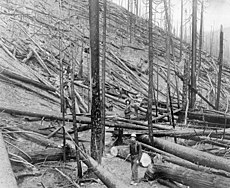 A pine forest on the Little North Fork of the St. Joe River, Idaho, after the fire | |
| Date(s) | August 20–21, 1910 |
|---|---|
| Location | Idaho, Montana, and Washington, United States British Columbia, Canada |
| Statistics | |
| Burned area | 3,000,000 acres (4,700 sq mi; 12,100 km2) |
| Land use | Logging, mining, railroads |
| Impacts | |
| Deaths | 87 |
| Non-fatal injuries | Unknown |
| Damage | Unknown |
| Ignition | |
| Cause | Not officially determined |

The Great Fire of 1910 (also commonly referred to as the Big Blowup, the Big Burn, or the Devil's Broom fire) was a wildfire in the Inland Northwest region of the United States that in the summer of 1910 burned three million acres (4,700 sq mi; 12,100 km2, approximately the size of Connecticut) in North Idaho and Western Montana, with extensions into Eastern Washington and Southeast British Columbia.[1] The area burned included large parts of the Bitterroot, Cabinet, Clearwater, Coeur d'Alene, Flathead, Kaniksu, Kootenai, Lewis and Clark, Lolo, and St. Joe national forests.[2] The fire burned over two days on the weekend of August 20–21,[3][4] after strong winds caused numerous smaller fires to combine into a firestorm of unprecedented size. It killed 87 people,[5] mostly firefighters,[6][7] destroyed numerous manmade structures, including several entire towns, and burned more than three million acres of forest with an estimated billion dollars' worth of timber lost.[2] While the exact cause of the fire is often debated, according to various U.S. Forest Service sources, the primary cause of the Big Burn was a combination of severe drought and a series of lightning storms that ignited hundreds of small fires across the Northern Rockies. However, the ignition sources also include human activity such as railroads, homesteaders, and loggers.[8] It is believed to be the largest, although not the deadliest, forest fire in U.S. history.[9][10]
In the aftermath of the fire, the U.S. Forest Service received considerable recognition for its firefighting efforts, including a doubling of its budget from Congress. The outcome was to highlight firefighters as public heroes while raising public awareness of national nature conservation. The fire is often considered a significant impetus in the development of early wildfire prevention and suppression strategies.[2]
- ^ Cite error: The named reference
NPRBigBurnwas invoked but never defined (see the help page). - ^ a b c Cite error: The named reference
AmExpwas invoked but never defined (see the help page). - ^ "More than seventy die in forest fires". Spokane Daily Chronicle. (Washington). August 22, 1910. p. 1.
- ^ "Find twenty more dead near Big Creek". Spokane Daily Chronicle. (Washington). August 24, 1910. p. 1.
- ^ Egan, Timothy. – "Ideas & Trends: Why Foresters Prefer to Fight Fire With Fire". – The New York Times. – August 20, 2000.
- ^ "1910 Fire Season". thinkquest.org. Inferno. Archived from the original on October 23, 2013. Retrieved July 1, 2013.(78 firefighters, 8 civilians)
- ^ "Deadliest incidents resulting in the deaths of 8 or more firefighters". nfpa.org. National Fire Protection Association. February 2012. Archived from the original on November 11, 2013. Retrieved July 1, 2013.(86 firefighters)
- ^ Tidweel, Tom (May 22, 2010). "Thinking Like a Mountain, About Fire". U.S. Department of Agriculture Forest Service. Retrieved August 31, 2024.
{{cite web}}: CS1 maint: url-status (link) - ^ Jim Petersen. "The West is Burning Up!". Evergreen Magazine (Winter Edition 1994–1995). Idaho Forest Products Commission. Archived from the original on October 31, 2000. Retrieved April 26, 2014.
- ^ Pulver, Dinah Voyles (April 29, 2024). "What is the biggest fire to burn in the US? The answer requires a journey through history". USA TODAY. Retrieved June 17, 2024.
